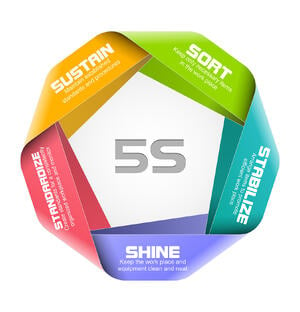March 4, 2015 | Lean, Continuous Improvement, Innovation & Growth, Business Growth Strategy & Strategic Planning
5 Lean Strategies for Your Sales & Marketing Teams
The business philosophy of lean manufacturing is all about optimizing a company’s workflow in order to maximize productivity. In the same way losing weight is all about exercising and cutting calorie intake, lean manufacturing focuses on reducing waste and innovating the way your team works.
Now, since the lean system is geared more towards hardcore production, it’s important to note that the system truly has no bounds. It can be applied to both your sales and marketing efforts.
The only “catch” lies in how your company is structured and your team’s willingness to be empowered. A well-established, top-down leadership is crucial to rearrange the work patten to which your team is accustomed. Having a manager that is well-respected, energetic and eager to apply a lean approach to business is the perfect combination that will make employees less apprehensive and more interested.
In the spirit of lean production, these managers can facilitate brainstorming sessions that can lead to game-changing suggestions and solutions. The more open a discussion becomes, the wider the window of opportunity grows.

Now, you may be asking: how does the philosophy of lean production affect sales and/or marketing?
Good question. In the same way you approach analyzing your physical production with lean manufacturing, there’s a sales kaizen strategy which uses similar practices for your sales and marketing teams to use.
To further optimize your current sales and marketing teams, we’ve broken down the most important elements so you can start analyzing and improving your workflow.
Value Stream Mapping for Sales
You and your customers have to be on the same page if you’re trying to gain a complete understanding of how your sales process works. By analyzing your sales process and the customer’s buying process, you can easily see areas that need improvement. Don’t forget: eliminating waste (things that don’t add value to the customer) should be a priority when aligning these two processes.
Once you’ve done the proper analysis and alignment, recreate the sales process so that it matches your customers’ needs. The more you scrutinize, the more effective your sales stream will become and in due time, you’ll experience a higher closing rate.
Apply the 5 S's
Sort. Set in order. Shine. Standardize. Sustain.

Those are the steps for the lean production’s 5S strategy. The strategy is all about cleaning up house and eliminating tools that aren’t needed in the sales or marketing process. Deciphering what’s crucial and what’s waste is a big part of optimizing your company. From rearranging the workspace to removing sales strategies that add nothing of value to your customer, this will refresh your approach to sales for a cleaner, smarter way of selling.
Don’t Forget to Value Your Quality (Qualification Criteria)
How valuable is your latest lead? Sure, sales and marketing has a lot to do with numbers, but knowing the quality of your list of leads allows you to work smarter.
Lead Nurturing & Lead Generation
How do you get your new clients? Do you truly understand their needs, concerns, insecurities?
By taking “sales” OUT of the equation and focusing on nurturing leads into interested prospects who trust in your services, much will change. Especially if your sales team controls every part of the sales process, going from lead generation to selling can be a little bit aggressive for first-time clients. Take a step back and keep the two separate lead strategies apart.
Sales Kaizen (PDCA)
Plan. Do. Check. Adjust. It’s all about continuous improvement.
Being able to pinpoint a problem easily gives you an advantage in moving ahead quickly by saving time addressing mishaps. By applying the lean production philosophy to sales and marketing, you’re bound to see positive results with a simple, easy-to-follow framework that will equally serve your team and clients.


Leave a Comment